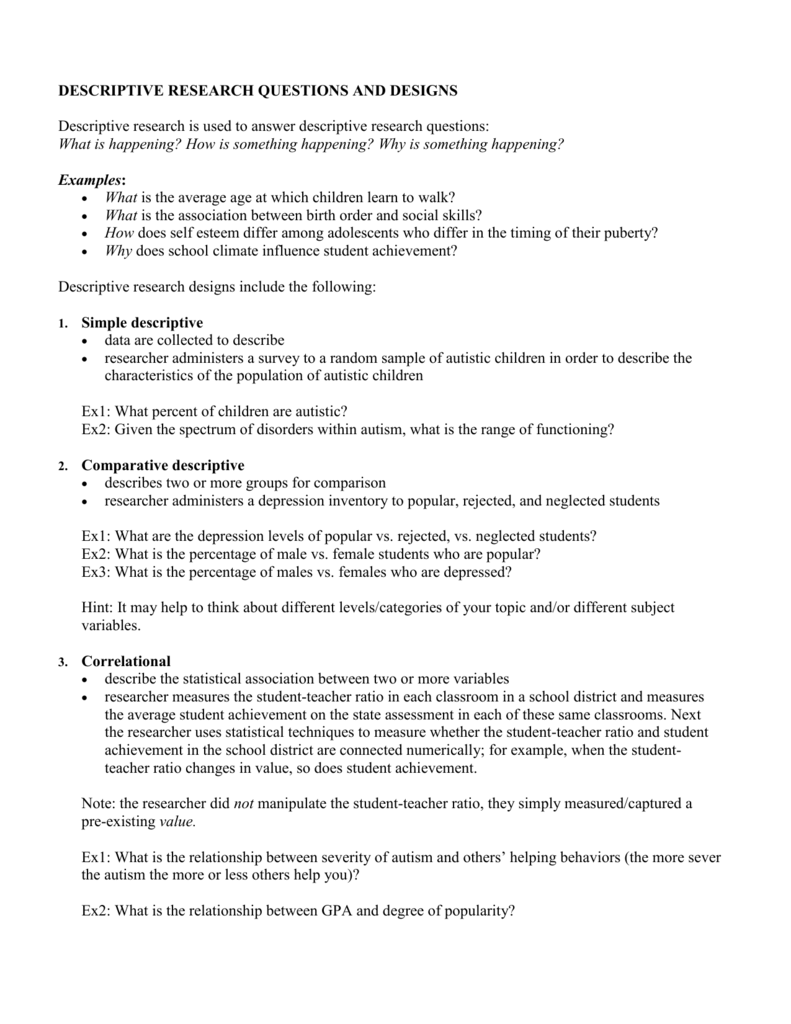Table Of Content

It always aims to answer how the event occurred, when it occurred, where it occurred, and what the problem or phenomenon is. Observations allow you to gather data on behaviours and phenomena without having to rely on the honesty and accuracy of respondents. This method is often used by psychological, social, and market researchers to understand how people act in real-life situations. Because descriptive research methods include a range of quantitative and qualitative research, there are several research methods you can use. Plus, the data collected from descriptive research can be subjected to other types of data analysis. While there are a number of descriptive research methods you can deploy for data collection, descriptive research does have a number of predictable characteristics.
Measuring data trends
The researcher’s own biases and preconceptions can influence the interpretation of the data. Descriptive research relies on existing data, which may not always be comprehensive or accurate. The absence of statistical and in-depth analysis and the rather superficial character of the investigative procedure are drawbacks of this research approach. However, there is no way to assess the findings because you don’t manipulate any variables statistically.
Dependence on Existing Data

The study will then uncover details on “what is the purchasing pattern of New York buyers,” but will not cover any investigative information about “why” the patterns exist. Because for the apparel brand trying to break into this market, understanding the nature of their market is the study’s main goal. Furthermore, it is important to minimize bias in all aspects of the study, from the selection of participants to the analysis of data. A clearly defined research question is the foundation of any research study, and it is important to ensure that the question is both specific and relevant to the topic being studied.
Data Collection Techniques

Descriptive research is often less expensive and less time-consuming than other research methods. Descriptive research is focused on describing and summarizing the characteristics of a particular population or phenomenon. Descriptive research data is analyzed to identify patterns, relationships, and trends within the data. Statistical techniques, such as frequency distributions and descriptive statistics, are commonly used to summarize and describe the data.
Characteristics of Descriptive Research Design
Using the data provided, researchers can analyze the data to understand what the election result will be. Using descriptive research, researchers will use surveys to understand who voters are more likely to choose out of the parties or candidates available. These characteristics in the population sample can be identified, observed and measured to guide decisions. Descriptive research findings may not be applicable to other populations or situations.
What is Descriptive Research? Definition, Methods, Types and Examples
These numbers can show patterns, connections, and trends over time and can be discovered using surveys, polls, and experiments. To reiterate, the advantages of descriptive research lie in its ability to provide a comprehensive overview, aid hypothesis generation, and serve as a preliminary step in the research process. However, its limitations include a potential lack of depth, inability to establish cause-and-effect relationships, and susceptibility to bias. If you’ve been wondering “What is descriptive research,” we’ve got you covered in this post!
(PDF) Journal of Advanced Zoology Knowledge and Attitude Regarding Vasectomy among Married Men in Rural Area ... - ResearchGate
(PDF) Journal of Advanced Zoology Knowledge and Attitude Regarding Vasectomy among Married Men in Rural Area ....
Posted: Sun, 15 Oct 2023 07:00:00 GMT [source]
Informative Data
Researcher.Life is a subscription-based platform that unifies top AI tools and services designed to speed up, simplify, and streamline a researcher’s journey, from reading to writing, submission, promotion and more. Based on over 20 years of experience in academia, Researcher.Life empowers researchers to put their best research forward and move closer to success. Descriptive research focuses on providing a detailed depiction of a phenomenon, while exploratory research aims to explore and generate insights into an issue where little is known.
Observation
In scientific inquiry, it serves as a foundational tool for researchers aiming to observe, record, and analyze the intricate details of a particular topic. This method provides a rich and detailed account that aids in understanding, categorizing, and interpreting the subject matter. A big advantage of this research type, is that you can use it to collect both quantitative and qualitative data.
Descriptive versus design sciences
To put it in another way, descriptive research precedes the hypotheses of explanatory research. It is particularly valuable when there is limited existing knowledge about the subject. The observational method is the most effective method to conduct this research, and researchers make use of both quantitative and qualitative observations. Descriptive research provides a comprehensive picture of the characteristics, behaviors, and attributes of a particular population or phenomenon, which can be useful in informing future research and policy decisions. A descriptive study design’s statistical capabilities allow researchers to track data trends over time.
The primary purpose of descriptive research is to describe the characteristics, behaviors, and attributes of a particular population or phenomenon. Descriptive research is often less expensive and less time-consuming than other research methods, making it a cost-effective way to gather information about a particular population or phenomenon. In this blog, we will explore the definition, characteristics, and common flaws in descriptive research design, and provide tips on how to avoid these pitfalls to produce high-quality results. Whether you are a seasoned researcher or a student just starting, understanding the fundamentals of descriptive research design is essential to conducting successful scientific studies. A descriptive research design is suitable for exploring certain topics and serving as a prelude to larger quantitative investigations. It provides a comprehensive understanding of the “what” of the group or thing you’re investigating.
This method involves comparing data across different groups or time periods to identify similarities and differences. Comparative analysis can help describe changes in attitudes or behaviors over time or differences between subgroups within a population. Selecting a representative sample is important to ensure that the findings of the study are generalizable to the population being studied. Researchers should use a sampling method that provides a random and representative sample of the population. Ethnographic research involves conducting detailed observations of a particular culture or community.
Quantitative studies are time- and resource-intensive, so knowing the hypotheses viable for testing is crucial. The basic overview of descriptive research provides helpful hints as to which variables are worth quantitatively examining. During descriptive research, you gather different degrees of interest over time from a specific population. Cross-sectional studies provide a glimpse of a phenomenon’s prevalence and features in a population. There are no ethical challenges with them and they are quite simple and inexpensive to carry out. Performing census surveys involves gathering relevant data on several aspects of a given population.

No comments:
Post a Comment